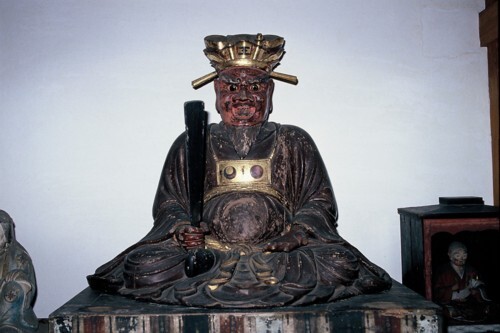Statue of King Enma at Jorakuji Temple

In Buddhism, it is believed that the deceased undergo trials by ten kings who judge their sins in the underworld (the world of Buddha), and their destined world is determined accordingly. The faith in these ten kings originated in the late Tang Dynasty in China, was introduced to Japan in the late Heian period, and became very popular during the Kamakura period. The ten kings are depicted wearing crowns, Taoist robes, holding scepters, and showing fierce expressions, reflecting strong Taoist influences. King Enma is one of these ten kings and is known as the king of hell. Additionally, Enma's sister is called Daikokuten, a demon woman who strips the clothes of people by the Sanzu River and hands them over to the hanging clothes old man in the trees.
At Jorakuji Temple in Higashi-Naganuma, there is a seated statue of Enma-O, designated as a Tokyo Metropolitan Cultural Property. It is located inside the Amida Hall (main hall), to the right of the Amida Triad statue, alongside the statue of Datsueba.
This statue of Enma-O is made using the yosegi-zukuri technique and is a seated figure with a height of 98.3 centimeters. It is fully painted, depicts an expression of open-mouthed anger, and is crafted with inlaid glass eyes.
There is an inscription on the inner abdomen of the statue that reads, "Created by Unkai Ikuyama, the chief priest and high-ranking monk of Jorakuji Temple in Bushu Tama Naganuma Village, on a leap day in September of the 12th year of Genroku (1669)." It is believed that Unkai Ikuyama, the head priest of Jorakuji Temple, made this statue in 1669, and it has been at Jorakuji Temple since its creation.
Created with exquisite carving techniques, it is considered an outstanding Buddhist statue from the mid-Edo period located in Minami-Tama.



Please let us know your feedback on how to make our website better.
Inquiries about this page
Inagi City Local History Museum
1-9-1 Hirao, Inagi City, Tokyo 206-0823
Phone number: 042-331-0660 Fax number: 042-331-0660
Contact the Lifelong Learning Division, Department of Education, Inagi City



















